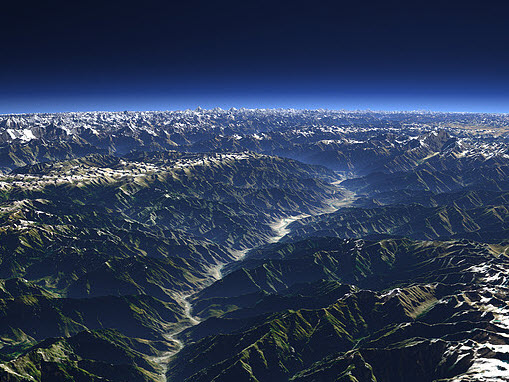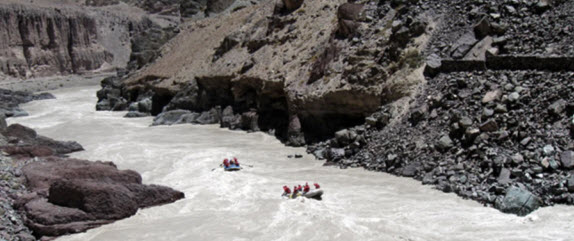This is the third installment in a four-part series. Read the second here.
Indus River
By the 4th day the river is dropping 100 feet per mile (by comparison, the Colorado through the Grand Canyon drops 7 feet per mile). There is more ground time than water time. Morale is dropping as fast as the river, and there is talk of mutiny and abandonment. Meanwhile, the local residents of the isolated gorge, who would sometimes gather by the hundreds, watch passively the labors of portaging. They rarely make a sound or display a hint of emotion or judgment. Most simply stare at the foreign navigators on an incomprehensible quest.
Finally a labyrinthine rapid breaks the river's course... it is a mess, defined by a series of rock columns and right-angle turns; but somehow it looks feasible, and everyone wants to avoid another portage. So, with half the team crouched in the bow, the first raft makes the entrance.
We drop down the tongue as planned, but at the tip, two recirculating crosscurrents bounce the boat like a ping pong ball in a pot of boiling water. We throw our weight from side to side and dig into the aerated water with paddles, desperately trying to force the boat out of the hydraulic, to no avail. The raft fills with water, which soon swirls around our chests. Finally, the current washes the raft up against a mid-river boulder, and we leap to the slippery top of the rock. On shore Jim Slade slings a 100-foot rescue line out to us, and we attach it to the bow, wherein the shore crew is able to pull it out of the washing machine, and as it passes our rock, we all leap into the bilge, out of the frying pan, into the fire.
Still brimming with water, the raft barrels out of control, and pitches downstream at a frightening speed. Grabbing buckets, we bail like madmen. I use my own hat, and try to kick out water at the same time. Another rapid is quickly approaching, hurling spray high into the sky, thundering its invitation. Oar strokes are having little effect on the swamped, ton-heavy raft, and 200 yards above the approaching rapid, expert rafter John Yost acts.
Leaping from the raft with bowline in hand, John swims for the crew on the left bank. His dive, however, has the effect of pushing the raft towards the opposite shore, orthogonal to the line John is frantically swimming. Hearing warning screams behind, Yost looks over his shoulder, sees the boat moving the wrong way, drops the bowline and swims for his life.
Both Yost and the raft make it to shore -- on opposite sides, at the lip of the falls. Slade and the crew of the second raft decide to portage.
For the next several days the pattern is of long spells of grueling, body-beating portages punctuated by moments of electrifying thrills running the huge standing waves. Then one afternoon, loud rumblings roll out of the distance at dusk. Avalanches? Glaciers groaning? Drones? A renewal of the Pakistan-India border conflicts over the region?
At daybreak we move about our morning tasks silently, like ghosts cleaning house. After packing the boats, we float into the source of the noise: a Pakistani army road crew is blasting cliffs 400 feet above the northern bank of the Indus to repair the all-weather highway connecting Skardu and Gilgit to Rawalpindi. Some 10,000 troops are involved in the task, motivated by Pakistan's claim to the region. The road's route is along a sheer rock cliff plagued with landslides, and one officer says that two men are lost for every mile of progress. He agrees to hold up blasting for four days, to allow us to pass beneath, but warns he will start up again on schedule, regardless of any western presence.
For four frenzied days, we unload the rafts, enlist jeeps to trundle personal equipment to a downstream campsite, portage as few rapids as possible and run others we would only attempt with a light boat. On the fifth day, as the expedition is fully loaded and on the river again, a peal of thunder splits the air. An entire cliffside is blown across the river just upstream; dust billows hundreds of feet into the sky, and rock shrapnel sprays the river like bullets, missing us by a few boat-lengths.
Day follows day in the dark confines of the gorge. After almost two weeks on the river, the configuration of two portages for every rapid run sets in. On the 15th day, another tortuous stretch confronts: a maze of boulders ringing the river like ramparts, followed by a 20-foot falls, with razor-backed rocks at its base. After the portage of the first raft -- a misadventure during which the bag containing the spare paddles is washed overboard and lost -- we all take a much-needed break and lunch on mutton and goat cheese. One of the guides, John Kramer, doesn't join in, however. He spends the repast staring at the rapid. When it comes time to portage the second boat, Kramer makes an announcement. "I don't want to jeopardize the expedition, but I'd like to try running this rapid. I think I can do it... alone. No extra weight."
Looks of surprise are exchanged, but no one protests. Nobody wants to portage again if not necessary...
The trip doctor then speaks up, "I'm worried about you."
"Hey, none of us is going to die of old age," Kramer squelches.
We then go about setting up safety lines at the rapids' finish. Kramer prepares himself out of sight upstream; the winds keen across the river and emphasize the silence that settles over the moment.
Then, from around the bend, the raft comes flying in mid-current, Kramer whooping as he executes pivots and pirouettes between the waves and holes, moving every bit like the dancer he was in college. As he arabesques toward the rapid's end, jaws drop along the shore: John Kramer is wearing no clothes, save his life jacket. Normal attire for the expedition has been a full wetsuit or baggy wool overclothing to guard against hypothermia in the frigid, glacial-melt waters of the Indus. But Kramer decides all the outerwear is too cumbersome for his dance, and too dangerous should he need his strength and agility in a swim. He slides between the sharp rocks at the end of the run, and pulls in with a worthy swagger and grin.

This is the third installment in a four-part series. Read the final part here.